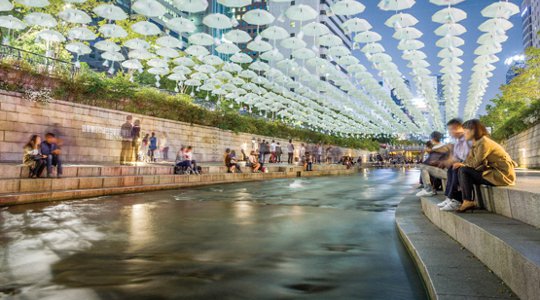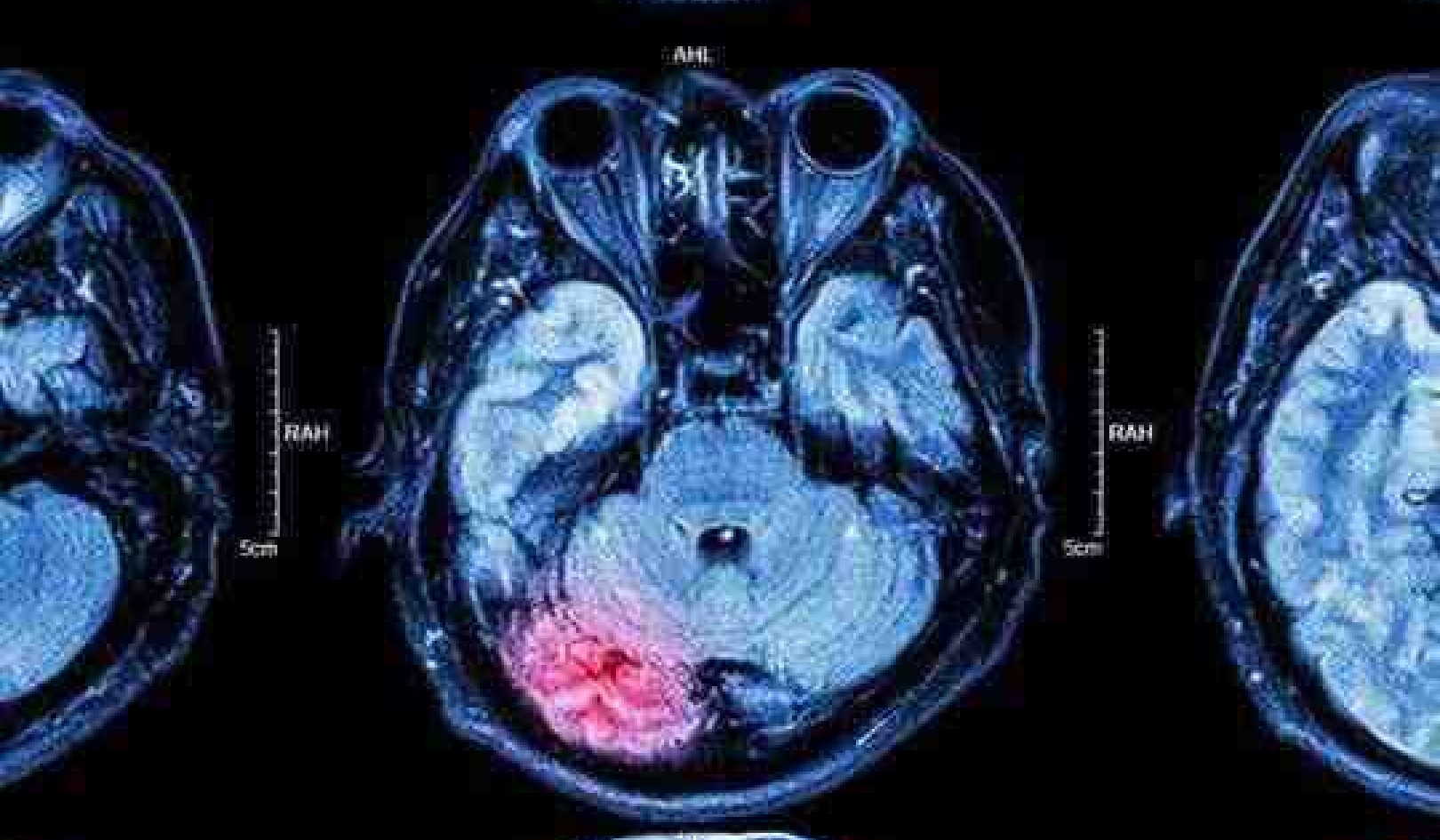 The seven-mile Cheonggyecheon Stream runs through downtown Seoul, South Korea. The stream had at one time been covered over by roads and eventually an elevated highway. In 2005 it was uncovered and turned into a popular public square. Photo by Adzrin Mansor.
The seven-mile Cheonggyecheon Stream runs through downtown Seoul, South Korea. The stream had at one time been covered over by roads and eventually an elevated highway. In 2005 it was uncovered and turned into a popular public square. Photo by Adzrin Mansor.
 f there’s one thing that’s certain, it’s that the future hasn’t happened yet. How we will live a few decades from now is anything but clear, despite predictions from our wisest architects, planners, politicians, philosophers, futurists, and science fiction writers.
f there’s one thing that’s certain, it’s that the future hasn’t happened yet. How we will live a few decades from now is anything but clear, despite predictions from our wisest architects, planners, politicians, philosophers, futurists, and science fiction writers.
For anyone committed to creating a more sustainable and just culture, here’s a sobering exercise: Try looking into the past as a way of tracking society’s expectations for itself. Look back a few decades and see how yesterday’s visionaries predicted we’d be living now.
In Our Vision of the Future, Is There Room for Nature and Non-Human Life?
I must do this routinely in my work in setting standards and developing tools for change at the International Living Future Institute. So I can tell you a common thread weaves through most fictionalized, artistic, and scientific forecasts: that the ongoing march of technological progress will continue unabated, further mechanizing our experience as humans and separating us from nature until everything we need is provided by machines and computers whose intelligence surpasses that of their operators. A companion theme in futuristic prophecies is the subjugation and taming of nature or, in extreme cases, nature’s total elimination. In these depictions, there is little room for nonhuman life.
Think for a moment about the sheer bulk of stories you’ve read and movies you’ve seen, and how many of them warn of a bleak future for society—books such as Aldous Huxley’s Brave New World and Cormac McCarthy’s The Road, and a catalog of dystopian cinema: Metropolis, Blade Runner, Road Warrior, Terminator, and WALL-E, just to begin the short list. The current epidemic of zombies chasing after us through our popular culture is, I think, nothing less than a psychological manifestation of our species’ sense of worthlessness. The undead trudge through our cities consuming us like a cancer. What better symbol of hopelessness and lack of self-worth could we possibly conjure up?
Get The Latest By Email
Out with the Old, and In with the New?
After World War II, there was a brief age of technological optimism. People, particularly Americans, believed in the promise of new frontiers. We saw residential and commercial potential in everything from our emerging suburbs to our rising office towers—we even pictured ourselves living “soon” on the moon or in terraformed space colonies.
In the mid-20th century, we were suddenly (and curiously) willing to dump models of living and community that had worked well for hundreds of years in favor of these new ideas. We raced to build an automobile-dependent world, lined with interstates and freeways that would provide the straightest path toward the idealized future. Usually these new freeways carved through our least affluent neighborhoods, separating rich from poor—and typically, black from white.
It is tragic that many of our first and largest social experiments in reshaping community were conducted in disadvantaged communities, most often populated by African American residents. Most of these social experiments supplanted viable working communities with “new urban visions” that increased crime and diminished community bonds. It should not be lost on us that planning paradigms have often tested ideas on the poorest among us, only to reinforce race and class distinctions once the polished plans are eventually implemented.
Communities Without Heart and Without Nature?
Many famous architects of the last century proposed plans for communities that, while well-intentioned at the time, had seriously negative outcomes. In 1924, architect and planner Le Corbusier unveiled his Radiant City, a proposal to bulldoze the heart of Paris and replace it with tall, monolithic towers—something Paris wisely ignored. Unfortunately, his ideas gained traction in American planning circles, and cities here lacked the wisdom of French city planners.
Chicago’s Cabrini Green and St. Louis’ Pruitt-Igoe (both public housing projects) mimicked Le Corbusier’s model only to be torn down after a few decades because the living conditions in these concrete environments grew so dreadful. Frank Lloyd Wright’s Broadacre City concept, which in the 1950s pictured “people living in parks connected by highways,” brought us the decentralized sprawl that now mars our landscapes, separates people from the natural world, and discourages healthy walkable communities.
Meanwhile, no positive, ecologically grounded conception of the future has been presented convincingly to counter these assumptions in our collective consciousness. Most futurists, whether basing their predictions on fact or fiction, seem so focused on techno-marvels they omit resilient environments and healthy communities from the stories they proffer. As a result, a more pessimistic, less natural set of mythologies has shaped our default assumptions about where we seem to be headed.
We have grown used to imagining an increasingly mechanistic future, with greater and greater densities, but what we have forgotten is that a future that crowds out the natural world is not simply bleak. It is impossible. A world without a healthy and vibrant natural biosphere cannot sustain human life.
Debunking the “Inevitable”: The Future Hasn't Happened Yet
Despite what the commercial real-estate industry or science-fiction authors might want us to imagine, our future does not have to be defined exclusively by megacities, mile-high skyscrapers, machines that do everything for us, and hyperdensity filled with flying cars. This “culture of inevitability,” defined by popular culture as well as market-driven development—despite being an imaginary concept—lulls us into inaction because it can seem futile to resist something so inescapable.
Remember: The future hasn’t happened yet. With enough people, wisdom, and ideas it’s possible to resist the culture of inevitability. We’ve done it before. Human history is filled with remakings of cities, towns, cultures, religions, governments, and more. We changed every community in America after World War II from ones that functioned primarily around walking and streetcars, to ones that function to serve automobiles. Now, clearly, it is time to switch to a more resilient paradigm. Human behavior is shaped in large part by our ability to pursue what we can imagine.
The task before us now is to harness the power of imagination to create a different future—one of our own choosing, and one crafted to sustain our communities, ourselves, and the other creatures with which we share this planet.
The Human Revolution: Re-imagining A More Livable Future
To take control of our next evolution, we must embrace and prioritize what it means to be human; what it means to live in concert with nature. Creating a truly living community will mean changing our role on—and as a part of—the planet. It starts by re-imagining our role as a species—not as separate from and superior to others, but inextricably linked to all other life and with a profound purpose as steward or gardener, helping to ensure that each act of our doing creates a net positive benefit to the greater web of life.
As we build examples of this new paradigm, it is essential that we do not use our most economically disadvantaged as guinea pigs.
Instead of Homo sapiens we become Homo regenesis (a term I have coined). Homo regenesis, which suggests moving beyond our current state as Homo sapiens, is suggestive of our next evolution to a state of being with a profound love of life; an affection for and affinity with living organisms and natural systems that is prioritized over a fondness for technology and mechanized systems. Understanding Homo regenesis means understanding the fundamental truth that only life can create conditions for life.
The Building Revolution: Building Models of The Future We Seek
Next we’ll need to build models of the future we seek—now. My organization, the International Living Future Institute, has been pushing the Living Building Challenge as an essential framework for all new buildings. With the Living Building Challenge we are proving it is possible to build within the carrying capacity of any given ecosystem— building structures that are completely powered by renewable energy, working within the water balance of a given site, treating their own waste, and doing so with materials that are nontoxic and local.
The Bullitt Center in Seattle is one such model—a six-story office building completely powered by the sun when averaged over the course of the year, with composting toilets on all six levels. The Bullitt Center is a symbol of a revolution in modern architecture: bigger than the majority of buildings in the United States, yet free from the burden and legacy of fossil fuels in the country’s least sunny major city.
Throughout the world, living schools, parks, homes, offices, and museums are cropping up in a variety of climate zones against various political backdrops. Currently more than 200 of these transformative buildings are taking shape in communities as far flung as New Zealand, China, Mexico, Brazil, and in nearly every U.S. state.
If these diverse projects can achieve Living Building Challenge goals, there is no limit to how broadly we can apply these systems. Because we now have the technology to build truly regenerative communities, it is no longer a stretch to imagine the “living” paradigm as the new normal.
The Scale Revolution: Building to the Scale of Inhabitants, Young and Old
Another relevant topic in the context of this discussion is something I call the “Boundary of Disconnect.” I define the Boundary of Disconnect as any system’s metaphysical and tactile boundary at which the individual (or any species or colony of species) is no longer able to connect or relate to the totality of the system itself. This concept is all about scale, and how we as humans should best live and relate to each other within the communities we build.
Instead of flying cars and moon colonies, Living Communities will be filled with ultra-efficient, nontoxic Living Buildings.
In our current model of the built environment, we typically develop without heeding scale, or build slavishly to the scale of the automobile. We binge on materials, energy, and water, climbing higher and sprawling farther without considering the natural, social, or emotional consequences. But if we were smarter about the appropriate scales for our systems— building, agriculture, transportation—we would minimize problems that arise from disconnectedness. As the writer Richard Louv put it: When density is disproportionate to nature and we are disconnected from our earthly surroundings, we succumb to “nature deficit disorder.”
When it comes to scale, a powerful litmus test for any community is its ability to support and nurture children. Child-centered planning would focus on our most precious and delicate citizens. It would heed the advice of Enrique Peñalosa, a former mayor of Bogotá, Colombia, who wrote, “Children are a kind of indicator species. If we can build a successful city for children, we will have a successful city for all people.”
The good news is that a child-centered city is not simply generous; it’s practical. And what nurtures small people often helps our elders as well. For starters (this is a very incomplete list) we would: Involve children in local food production. Sprinkle bike racks, sport courts, public art, and natural playgrounds throughout the city. Eliminate poisonous substances from the built environment. Design sheltered public waiting areas. Install swings designed for all ages across the metropolis. Create “sound parks” powered by fountains, wind chimes, drums, and live-music performances that amplify the music of nature. Scatter courtyards linked to public spaces that offer acoustic and visual privacy from the street. Get rid of most advertising.
Even if more and more people are moving to cities, we can design streets, sidewalks, and pathways at a scale that is safe and pleasant when experienced by someone under four feet tall rather than designing everything around the scale of 3000-pound automobiles. We can design neighborhood features that support child development through welcoming natural systems such as flowing water, trees, and a myriad of ways for children to interact with the living world rather than merely being presented with a lifeless concrete jungle.
The Living Community Revolution: Supporting Strong Social and Cultural Networks
Ultimately, Living Communities of the future are both scaled to the human dimension and include functioning ecological systems throughout, where greater biodiversity and resilience can occur. Instead of flying cars and moon colonies, Living Communities will be filled with ultra-efficient, nontoxic Living Buildings that generate their own energy on-site using renewable resources, capture and treat their own water, are made of nontoxic sustainably sourced materials, and inspire their inhabitants. But only if we start imagining and insisting now.
The game-changing success of the Living Building Challenge is proof that Living Communities are feasible within a fabric that supports strong social and cultural networks. As we imagine and then build examples of this new paradigm, it is essential that we do not use our most economically disadvantaged as guinea pigs. Indeed, the human dimension of our cities must be carefully considered as we go forward to overcome the legacy of racial and economic prejudice that has pervaded city planning in the past.
Perhaps in the future, popular books and films will portray how we overcame mind-numbing odds and defeated the seemingly unstoppable Culture of Inevitability, and instead embraced a new vision for the way we will live on the planet—one that puts people and life squarely where they belong: at the heart of our communities.
This article appears in Cities Are Now,
the Winter 2015 issue of YES! Magazine.
Additional subtitles by InnerSelf.com
About the Author
 Jason F. McLennan wrote this article for Cities Are Now, the Winter 2015 issue of YES! Magazine. Jason is CEO of the International Living Future Institute. He is the creator of the Living Building Challenge, as well as the author of five books, including his latest: Transformational Thought. Visit his website at jasonmclennan.com/
Jason F. McLennan wrote this article for Cities Are Now, the Winter 2015 issue of YES! Magazine. Jason is CEO of the International Living Future Institute. He is the creator of the Living Building Challenge, as well as the author of five books, including his latest: Transformational Thought. Visit his website at jasonmclennan.com/
 Book by this Author:
Book by this Author:
Transformational Thought: Radical Ideas to Remake the Built Environment
by Jason F. McLennan.
Click here for more info and/or to order this book.
Read an article about Cheonggyecheon Stream which runs through downtown Seoul in South Korea







